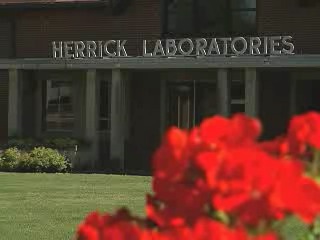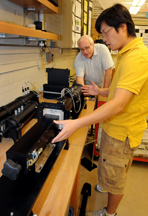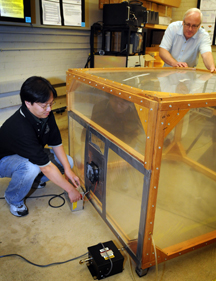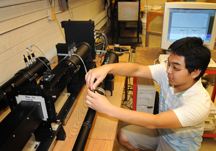
| VIDEO |
 * A $2 million gift from alumnus Gerald Hines completes fundraising for new labs that will research green technologies. (2 minutes 31 seconds) * A $2 million gift from alumnus Gerald Hines completes fundraising for new labs that will research green technologies. (2 minutes 31 seconds) |
| RELATED WEB SITES |
| * Patricia Davies |
| * Ray W. Herrick Laboratories |
| * School of Mechanical Engineering |
| RELATED INFO |
| * History and research at the Herrick Laboratories |

September 15, 2008
Alumnus completes $11 million drive for Purdue industry-oriented laboratory
WEST LAFAYETTE, Ind. - |
The labs - administered by the School of Mechanical Engineering - are a hub of industry-oriented research in areas ranging from advanced automotive technologies to "smart" buildings.
"The Herrick Labs has an impressive legacy of balancing the needs of industry, academics and basic research," said Purdue President France A. Córdova. "Now Purdue is going to ensure that legacy continues by providing more spacious and modern facilities for this important work."
The announcement kicks off Green Week at Purdue and across the Lafayette-West Lafayette community. Green Week is a grassroots effort to take positive action to support the environment, curb energy consumption, develop alternative fuels and address related issues. The week will feature alternative transportation, recycling, campus and community presentations, green computing and a detrash the Wabash River day, among other efforts.
 |
The Herrick Laboratories were established in the 1950s with a grant from Ray W. Herrick, then CEO of Tecumseh Products Co., in Tecumseh, Mich. Since then, about 600 Herrick students have completed graduate and doctoral degrees.
"Herrick Labs is a place where students learn about industry-relevant problems and contribute, through their research, to solving these problems," said Leah Jamieson, the John A. Edwardson Dean of Engineering and Ransburg Distinguished Professor of Electrical and Computer Engineering. "Herrick graduates are valued for their technical expertise and know-how for making products more efficient, more environmentally friendly and more people friendly."
The new facility will include the Gerald D. Hines Sustainable Buildings Technology Laboratory, which will focus on new building technologies and their impact on human behavior and productivity, said E. Daniel Hirleman, professor and William E. and Florence E. Perry head of the School of Mechanical Engineering.
The lab will be designed to be LEED certified, an acronym for Leadership in Energy and Environmental Design, the second such facility on campus after the Roger B. Gatewood Wing of the Mechanical Engineering Building, which is currently under construction and is expected to be completed in the summer of 2011. The certification was developed by the U.S. Green Building Council, a non-profit organization dedicated to sustainable building design and construction
 |
Hines graduated in 1948 with a degree in mechanical engineering at Purdue. He moved to Houston after graduating from Purdue and went to work for a large national engineering company. In 1951 he joined Texas Engineering as a partner and then formed Gerald D. Hines Interests.
The Houston-based company is now one of the largest real estate firms in the world, with operations in the United States and 15 other countries.
"The Sustainable Buildings Technology Laboratory is a leading-edge concept that will have a great impact on helping our industry improve the energy efficiency of buildings and make them more environmentally friendly," Hines said. "I am pleased to be in a position to support this very important project."
The new Herrick building also will include the Perception Based Engineering Laboratory, funded by Ford Motor Co.
 |
Ongoing research in the Perception Based Engineering Lab is led by Patricia Davies, director of the Herrick labs and a professor of mechanical engineering. The lab focuses on understanding factors contributing to occupant perceptions of quality, with projects on noise and sound quality, indoor air quality, thermal comfort, visual perception, and touch.
The Herrick Labs, which held a 50th anniversary celebration in July, are housed in a brick horse barn originally built a century ago near State Street and Russell Drive.
"The current building's infrastructure and utilities now limit the scope of research that we can do," Davies said. "Given the special-purpose facilities needed for much of our research, the expansion is a challenging endeavor."
The $11 million raised for the project includes donations of $3.5 million from alumnus Roger B. Gatewood, $3 million from Ford Motor Co., and $1 million apiece from the Herrick Foundation and Cummins Inc.
The university currently is selecting an architect. The new building, currently planned to be located adjacent to Herrick south of State Street between Martin Jischke Drive and Steven Beering Drive, initially may encompass a total of 32,000 square feet and is expected to be completed by 2012. It will house offices and experimental facilities for more than 90 graduate students, 25 faculty, postdoctoral researchers and visiting researchers, as well as technical and administrative staff.
Another unit to be included in the new building is the Cummins Power Laboratory, funded by Cummins Engine Co. Research will focus on reducing the environmental impact and improving the efficiency of diesel and internal combustion engines and will include projects on renewable energy and hydrogen power.
 |
"The wide scope of the research conducted at the laboratories will require demanding specifications for the new building, in particular, the need for acoustic and vibration isolation in various parts," Davies said. "Some areas will require background noise and vibration levels to be below human perception thresholds, and in these areas an ability to precisely control environmental parameters will be critical."
The offices and meeting rooms also will constitute a "living" laboratory that will help bridge the gap between new prototype technologies arising from fundamental research and conventional technologies used in new buildings.
"This will involve reconfigurable heating, ventilation and cooling systems and building envelopes so that new concepts can be tried out in a realistic setting," Davies said. "Actual energy efficiency, occupant comfort and productivity in a working building can be monitored and the information used to make refinements to proposed technologies. This will ensure much more successful and predictable implementation of new technologies in buildings."
Advanced building designs will address issues including water conservation, using natural lighting and recycled materials, and other steps to conserve energy and resources.
"The overall concept behind the new Herrick labs is to go 'beyond green,'" Davies said. "We will learn through research how to further increase energy efficiency and lower environmental impact and also integrate occupant comfort and productivity into building design objectives so that you design spaces that people actually want to be in. The living lab is important because we want to be able to demonstrate that concepts work and identify where the problems are so that they can be addressed."
The Hines lab will be a leading incubator for sustainable building technologies.
Research associated with the Perception-Based Engineering Lab explores learning how people react to a product and their environment.
"If you are designing products that impact people, it makes sense to study how people perceive factors such as sound, vibration, temperature, lighting and other elements," Davies said. "Then you can integrate human experience into the design of products.
"The new facility will enable us to study issues in a much more sophisticated way, so we could study sound and vibration together, or vision and noise, or we could look at productivity in a noisy, hot and humid environment and examine tradeoffs between thermal and acoustic comfort or air quality. We will look at the effects of the environment on the people working in them in terms of comfort, productivity and health, and we will couple our findings with engineering models to enable an integrated perception-based engineering approach to designing complex systems such as buildings and machines"
Writer: Emil Venere, (765) 494-4709, venere@purdue.edu
Sources: France A. Córdova, (765) 494-9708
Patricia Davies, (765) 494-9274, daviesp@purdue.edu
Leah H. Jamieson, (765) 494-5346, lhj@purdue.edu
Purdue News Service: (765) 494-2096; purduenews@purdue.edu
Note to Journalists: Video B-roll is available from the Purdue News Service by contacting Jim Schenke at (765) 494-6262, jschenke@purdue.edu
PHOTO CAPTION:
Researchers at Purdue's Ray W. Herrick Laboratories are developing fuel-flexible combustion control strategies that enable highly efficient, ultra-low emission combustion of both conventional and domestically available alternative diesel fuels, including biodiesel and coal-derived liquid fuels. Gregory Shaver, at right, an assistant professor of mechanical engineering, works with graduate students Gayatri Adi, left, and Mike Bunce to prepare for biodiesel testing with a 2007 Cummins turbo-diesel engine. Graduate student Karla Stricker, in window at right, monitors data acquisition. (Purdue News Service photo/David Umberger)
A publication-quality photo is available at https://www.purdue.edu/uns/images/+2008/shaver-HerrickAdv.jpg
PHOTO CAPTION:
Purdue mechanical engineering doctoral student Taewook Yoo and J. Stuart Bolton, a professor of mechanical engineering, prepare to operate a system that measures the acoustical properties of new perforated, acoustical materials at the university's Ray W. Herrick Laboratories. The engineers are using the system in research to develop new, space efficient materials that make for quieter environments, such as the interior of a car, aircraft or building. The research is being led by Stuart Bolton. (Purdue News Service photo/David Umberger)
A publication-quality photo is available at https://www.purdue.edu/uns/images/+2008/bolton-tube.jpg
PHOTO CAPTION:
Purdue mechanical engineering doctoral student Yoon-Shik Shin and J. Stuart Bolton, a professor of mechanical engineering, work on a system that measures how much sound a typical computer fan makes. The research, based at Purdue's Ray W. Herrick Laboratories, aims to reduce noisy office and home environments where audiovisual and information technology equipment is used. (Purdue News Service photo/David Umberger)
A publication-quality photo is available at https://www.purdue.edu/uns/images/+2008/bolton-cube.jpg
PHOTO CAPTION:
Purdue mechanical engineering master's student Kang Hou places a testing sample inside a system that measures the acoustical properties of materials at the university's Ray W. Herrick Laboratories. The engineers are developing more accurate methods for quantifying materials that will be used to create quieter environments in transportation and building systems. The research is being led by Professor J. Stuart Bolton. (Purdue News Service photo/David Umberger)
A publication-quality photo is available at https://www.purdue.edu/uns/images/+2008/bolton-student.jpg
To the News Service home page
